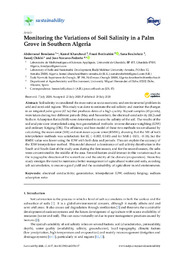Please use this identifier to cite or link to this item:
https://hdl.handle.net/11000/37975Full metadata record
| DC Field | Value | Language |
|---|---|---|
| dc.contributor.author | Benslama, Abderraouf | - |
| dc.contributor.author | Khanchoul, Kamel | - |
| dc.contributor.author | Benbrahim, Fouzi | - |
| dc.contributor.author | Boubehziz, Sana | - |
| dc.contributor.author | Chikhi, Faredj | - |
| dc.contributor.author | Navarro-Pedreño, Jose | - |
| dc.contributor.other | Departamentos de la UMH::Agroquímica y Medio Ambiente | es_ES |
| dc.date.accessioned | 2025-11-07T11:17:29Z | - |
| dc.date.available | 2025-11-07T11:17:29Z | - |
| dc.date.created | 2020-07-29 | - |
| dc.identifier.citation | Sustainability 2020, 12(15), 6117 | es_ES |
| dc.identifier.issn | 2071-1050 | - |
| dc.identifier.uri | https://hdl.handle.net/11000/37975 | - |
| dc.description.abstract | Soil salinity is considered the most serious socio-economic and environmental problem in arid and semi-arid regions. This study was done to estimate the soil salinity and monitor the changes in an irrigated palm grove (42 ha) that produces dates of a high quality. Topsoil samples (45 points), were taken during two di erent periods (May and November), the electrical conductivity (EC) and Sodium Adsorption Ratio (SAR) were determined to assess the salinity of the soil. The results of the soil analysis were interpolated using two geostatistical methods: inverse distance weighting (IDW) and ordinary Kriging (OK). The e ciency and best model of these two methods was evaluated by calculating the mean error (ME) and root mean square error (RMSE), showing that the ME of both interpolation methods was satisfactory for EC (0.003, 0.145) and for SAR (0.03, 0.18), but the RMSE value was lower using the IDW with both data and periods. This can explain the accuracy of the IDW interpolation method. This model showed a dominance of soil salinity distribution in the South and South-East of the study area during the first season, and for the second season, the salts were concentrated in the middle of the area. Several factors could interact in this variation such as the topographic direction of the water flow and the aridity of the climate (evaporation). From this study emerges the need to maintain a better management of agricultural water and soils, avoiding salt accumulation, to ensure a good yield and the sustainability of agriculture in arid environments. | es_ES |
| dc.format | application/pdf | es_ES |
| dc.format.extent | 19 | es_ES |
| dc.language.iso | eng | es_ES |
| dc.publisher | MDPI | es_ES |
| dc.rights | info:eu-repo/semantics/openAccess | es_ES |
| dc.rights | Attribution-NonCommercial-NoDerivatives 4.0 Internacional | * |
| dc.rights.uri | http://creativecommons.org/licenses/by-nc-nd/4.0/ | * |
| dc.subject | electrical conductivity | es_ES |
| dc.subject | geostatistics | es_ES |
| dc.subject | interpolation IDW | es_ES |
| dc.subject | ordinary kriging | es_ES |
| dc.subject | sodium adsorption ratio | es_ES |
| dc.subject.other | CDU::5 - Ciencias puras y naturales | es_ES |
| dc.title | Monitoring the Variations of Soil Salinity in a Palm Grove in Southern Algeria | es_ES |
| dc.type | info:eu-repo/semantics/article | es_ES |
| dc.relation.publisherversion | https://doi.org/10.3390/su12156117 | es_ES |

View/Open:
42_sustainability-12-06117.pdf
3,17 MB
Adobe PDF
Share:
.png)
